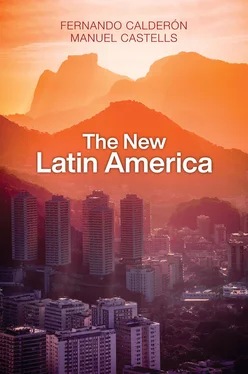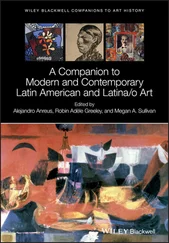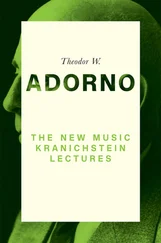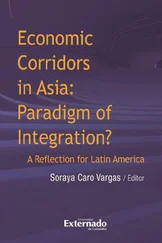Most especially, we would also like to express our gratitude to the people who offered us technical assistance during the last stages of production: Caterina Colombo, for her crucial statistical and documentary support; Noelia Díaz López of the Universitat Oberta de Catalunya, for her excellent preparation and organization of the book’s manuscript; and Pauline Martinez of the University of Southern California, for logistical support during the final phase of the project.
This work is the product of a complex Socratic journey, through which we sought to understand recent changes in Latin America. We have had the good fortune to rely, as always, on our loved ones. Many thanks to them for their support and their patience: to Alicia, Manuel, Coral, and Daniel from Fernando; and to Nuria, Irene, and José from Manuel.
As always, our friend and teacher Alain Touraine is a presence in this book.
Finally, we acknowledge the Editorial Fondo de Cultura Económica and especially Julio Sau Aguayo, our editor and friend, with thanks for the support for this book’s publication and for inspiring other, past books as well.
PREFACE TO THE ENGLISH EDITION
At the time when this translation went into production (January 2020), Latin America had exploded. The streets of Ecuador, Chile, Bolivia, and Colombia filled with people protesting against government policies and ruling elites. Argentina elected a progressive president after a wave of social protests against the neoliberal policies of the administration of Mauricio Macri, policies that reduced social benefits, increased poverty, and ultimately led to hyper-inflation, placing the country once again under the fiscal control of the International Monetary Fund. Peru was still reeling from a constitutional conflict between the provisional president (replacing a dismissed president) and congress. Brazil was painfully waking up to the reality of Jair Bolsonaro’s authoritarianism. Venezuela persisted in a political stalemate, a conflict between the president and congress resulting in frequent and violent street confrontations. Uruguay, the most stable country in South America, suddenly turned to the right thanks to popular support for an ultra-conservative force led by a retired general defending the country’s military dictatorship. And Mexico was facing a new round of assaults by violent narcos , who went so far as to occupy the city of Culiacán, capital of Sinaloa, for a day, after defeating the army unit sent to arrest their leader at the request of the US Drug Enforcement Administration. In each of these cases, the causes of the protests and of the ensuing political instability were specific to the individual countries. However, a number of common threads can help to explain the conflicts and confrontations that emerged from beneath a misleading calm. This book identifies and investigates the processes that led to the emergence of simultaneous social and political crises in most of Latin America. Indeed, when a decade ago we sought to understand Latin America’s transformation in the twenty-first century, we did not intend to study each country in isolation. Instead, we explored a few trends that, taken together, explained the transformations that we observed in every country, although these changes had different degrees of relevance to and intensity in each of the societies we studied.
There are connections between the key developments identified in this book and the events that took place in the second half of 2019 and shocked South America’s elites. In fact, these events did not surprise us. We did not predict them, as prediction is not the task of social scientists like us. We simply detected and explained traits and trends in the social structure and social dynamics whose unfolding has resulted in the social disruption and political change that we are witnessing.
We started our investigation, and this book, by studying the contradictory processes through which Latin America was incorporated into the global economy at the turn of the millennium. For the sake of simplicity, we identified two successive economic models that guided the globalization of Latin America. We named these neoliberalism and neo-developmentalism. Under neoliberalism, market forces provided the template for restructuring both the economy and society, for implementing the mantra of the so-called “Washington Consensus”. In most cases, these policies induced export-oriented economic growth, increased competitiveness, and improved technological infrastructures, particularly in telecommunications, digitization, and transportation.
Yet full-scale privatization and reductions in social spending resulted in poverty, rampant inequality, low wages, a lack of social benefits, particularly in pensions, and an expansion of the informal economy, as economic growth was not matched by growth in employment. Key services such as education and healthcare were left to self-financing by families, creating unbearable debt burdens. Erratic fiscal policies in several countries, in the absence of effective taxation of elites and corporations, prompted bursts of inflation that were controlled by sharp policy turns to austerity, destabilizing the economy and social life. The social inequity of this model triggered a wave of protests that shook up political order, although the timing of these protests, and their political impact varied from country to country. The neoliberal model ultimately collapsed in all countries under the pressure of social protests and political alternatives.
The emergence of left-wing governments with different ideological orientations, particularly in Venezuela, Argentina, Brazil, Uruguay, Bolivia, Ecuador, and Mexico, changed the political map of Latin America. Government policies shifted to a new model, one that we call neo-developmentalism. This model was characterized by active state intervention, an emphasis on the development of productive infrastructure, and an export-oriented model of what we call informational extractivism, guided by the state, together with substantial efforts at social redistribution and anti-poverty policies. Neo-developmentalism triggered new forms of social opposition that ultimately led to its political demise. The sources of this opposition were, on the one hand, the hostility of business elites who found their privileges threatened, particularly in terms of taxation, and, on the other hand, the growing corruption of state bureaucracies, largely to support the parties in government, in a context of rapid state expansion. Paradoxically, a segment of the new middle classes created by the redistribution of incomes and opportunities opposed left-wing governments, as these middle classes also came to defend their newly acquired privileges.
Thus the neo-developmental model, like the neoliberal one, crumbled under the pressure of socio-political opposition from large sectors of society. After two decades of successive rise and fall of the two models, entire Latin American economies and societies were in disarray, and this opened the path to a potentially chaotic situation. However, the timing of the rise and fall of the two models varied, and this complicates our interpretation of the situations in various countries. Venezuela exploded first to counter a corrupt elite that had sent the majority of the population in a rich country into poverty. The country collapsed as a corrupt military elite took over, replacing the old conservative elites and resisting new demands for democracy, inducing a systemic crisis whose denouement is perhaps still to come in Caracas. Chile exploded last, in part because of the inclusionary social orientation of the neoliberalism introduced by the Concertación, which gave way to a completely free market system under Sebastián Piñera, ultimately provoking a groundswell of opposition in the entire region. Colombia, a case of economic neoliberalism with extreme inequality, lived through a long period of institutional uncertainty under the effects of the longest-lasting guerrilla war in Latin America, made crueler by drug cartels and the paramilitary forces created by the US-designed “Plan Colombia.” As soon as the country started to live in relative peace, its citizens joined the movement of street protests, which included new political actors at the local level. Mexico emerged from a deadly combination of neoliberalism and narco-terrorism with a last call for survival under the presidency of Andrés Manuel Lopez Obrador. The new president, elected by a large majority, went in search of policies that would have learned from the mistakes of both preceding models in Latin America.
Читать дальше












